Artist Claude Monet & His Art Work Garden at Giverny 1900
Nestled in the quaint French village of Giverny lies a hidden gem that radiates with the vibrant strokes of artistic genius – Claude Monet’s famous impressionist masterpiece, The Artist’s Garden at Giverny, 1900.
Renowned as one of the pioneers of Impressionism, Monet’s brushstrokes dance effortlessly between light and color on oil on canvas, capturing fleeting moments with unparalleled grace.
His dedication to painting en plein air not only revolutionized art but also paved the way for a new era of creative expression.
As we embark on this journey through Monet’s enchanted garden, we unravel more than just petals and leaves meticulously arranged by the artist’s hand – we unearth fragments of his soul woven into every petal and whispering breeze.
The Artist’s Garden stands not merely as a horticultural spectacle but as an immersive canvas where nature harmonises with art in exquisite unity, reflecting the essence of Monet’s painting style.
Amongst the vivid blooms and tranquil ponds lie echoes of inspiration that breathed life into some of Monet’s most iconic works, blurring the lines between reality and imagination, and making the garden became a subject of world-renowned art prints.
So come forth, curious explorers and art aficionados alike, and witness how the garden became a masterpiece immortalised in the garden at Giverny by Claude Monet prints.
Join us as we traverse through time and space to delve deeper into the essence of Monet’s botanical symphony at Giverny – a sanctuary where passion blossoms under open skies, awaiting eager hearts to behold its boundless beauty anew.
Prepare to lose yourself amidst verdant corridors teeming with creativity; for within these gardens lies not just flora, but an eternal ode to artistic prowess that transcends mere sight – it beckons you to feel, dream, and discover alongside one of history’s greatest visionaries.
HISTORY OF ARTIST CLAUDE MONET OEUVRE & EVOLUTION OF GARDEN AT GIVERNY
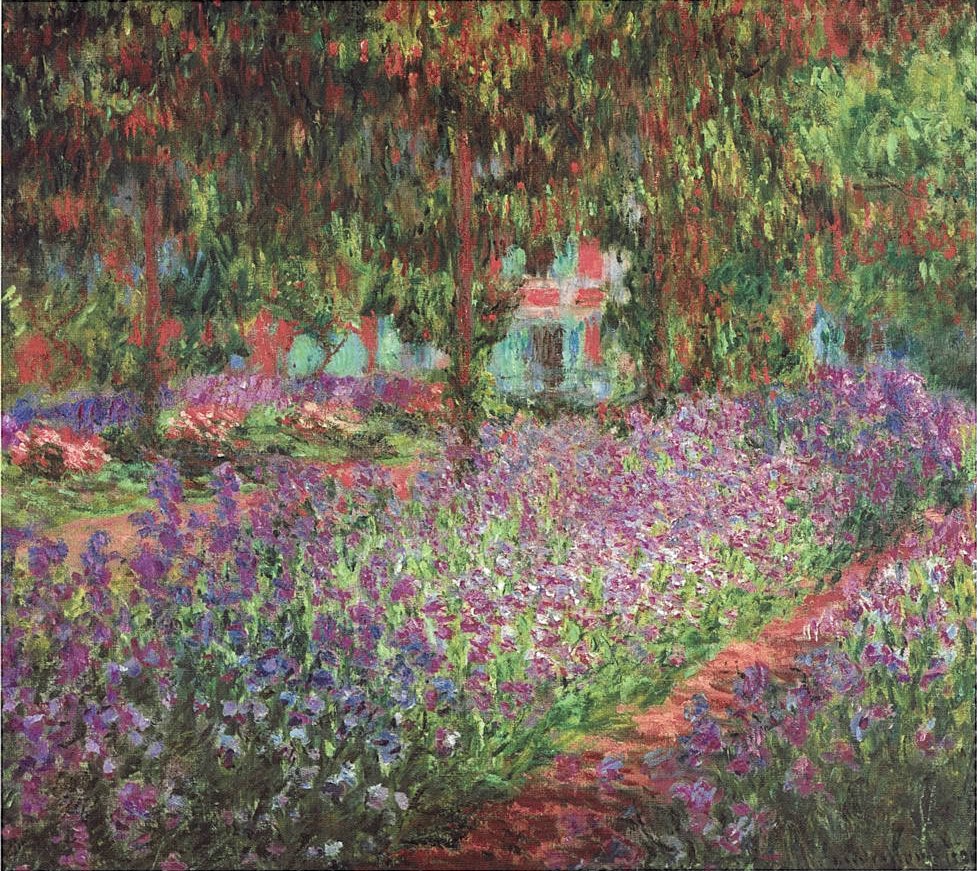
In the context of Monet’s extensive Oeuvre, Claude Monet completed this painting at the age of 60, having already achieved remarkable success and fame. At this stage in his career, Monet’s artistic vision had evolved to a point where, as noted by William Seitz, “subject, sensation, and pictorial object have all but become identical.”
In the year 1900, when this painting was created, Monet undertook two significant projects: a series capturing the River Thames in London and another series featuring his water gardens in Giverny, which included iconic works like The Waterlily Pond (now housed in the Museum of Fine Arts, Boston). Concurrently, Monet’s dealer Durand-Ruel exhibited recent works, prominently featuring a dozen Waterlilies. Additionally, Monet purchased his friend Renoir’s painting Mosque (Arabian Festival), further enriching his artistic circle and inspiration.
Monet’s artistic journey at Giverny was a meticulous transformation of nature into a living canvas, where each stroke of his brush found resonance in the vibrant petals and lush foliage. What began as a modest country property gradually morphed into an immersive paradise under Monet’s visionary brushstrokes.
Over several decades, he sculpted the landscape with an artist’s eye, planting trees strategically to catch the play of light or positioning flowers to harmonise in a symphony of hues, an approach that made his garden become a living art print.
The evolution of Giverny mirrored Monet’s own growth as an artist, reflecting his changing techniques and artistic philosophy through every petal and pond, showcasing the garden at Giverny by Claude.
Central to Monet’s enchanting world were the colours that danced across his garden like notes on a painterly score.
His keen understanding of colour theory manifested in deliberate choices that transformed Giverny into a kaleidoscope of sensory richness, a transformation often celebrated in fine art galleries through prints by Claude Monet.
From the tranquil blues and purples of water lilies floating serenely on ponds to the fiery reds and oranges bursting forth from poppy fields, each corner held a chromatic narrative waiting to be discovered.
Through this curated palette, Monet orchestrated not just botanical beauty but emotional landscapes, inviting viewers to experience nature through tinted lenses that heightened every sight, scent, and sound within the garden’s embrace.
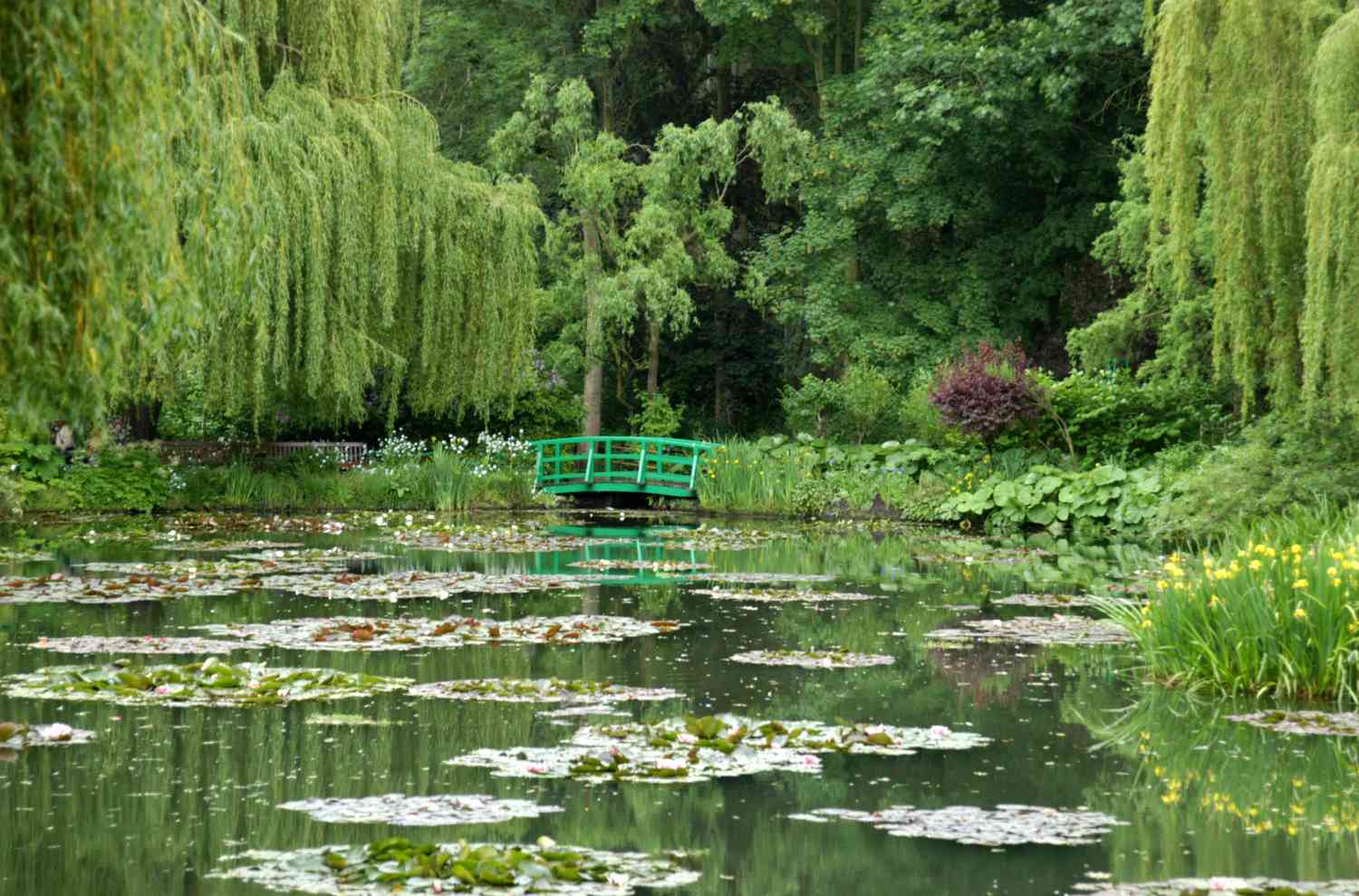
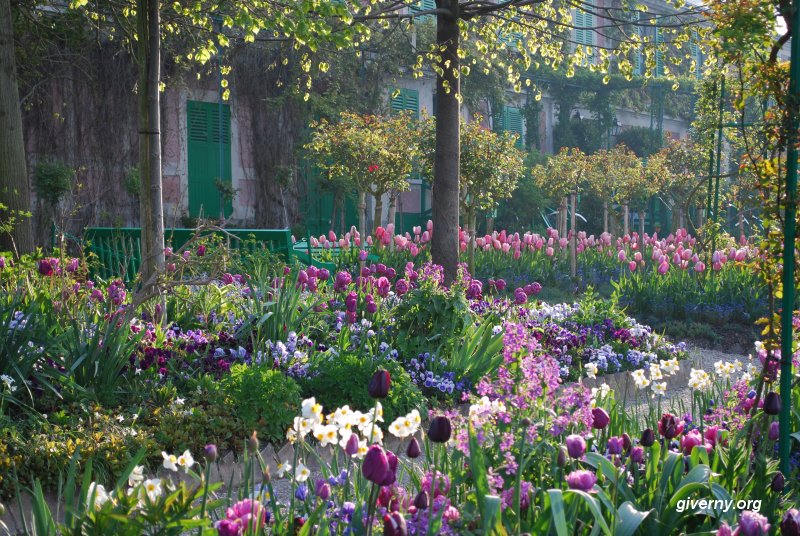
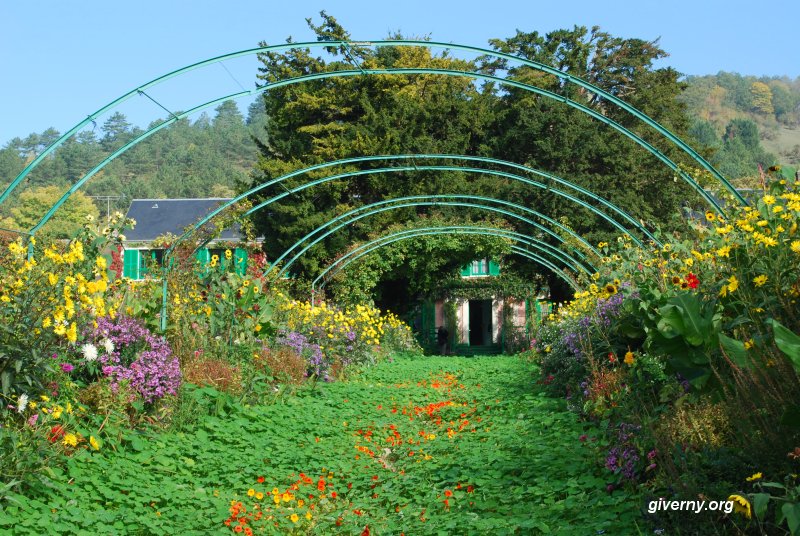
Elements & Design
As visitors step into Claude Monet’s garden at Giverny, they are immediately greeted by the enchanting sight of the water lilies pond.
This iconic feature, immortalised in many of Monet’s masterpieces, serves as the focal point around which the entire garden seems to revolve, offering endless inspiration for wall art and gallery installations.
The reflections of the sky and surrounding flora dancing on its tranquil surface create a mesmerising play of light and colour that inspired some of Monet’s most breathtaking works, often reproduced on fine art prints.
With each gentle ripple and duck gliding across its mirrored expanse, one can almost hear the whispers of artistic muses calling out from its depths.
Winding paths lead guests further into the heart of this living canvas, guiding them towards another emblematic element: the Japanese bridge.
Symbolic of Monet’s fascination with Eastern artistry, this elegant structure acts not just as a crossing point but as a gateway between worlds – bridging Western formalism with Eastern serenity and inspiring many prints by Claude Monet.
Its graceful arches frame picturesque views like windows onto nature’s symphony, inviting contemplation and creativity to flow freely beneath their sheltering embrace.
Through meticulous placement and thoughtful juxtapositions, Monet orchestrated these elements like notes in a harmonious composition, blending earthy textures with ethereal tones to craft a living tapestry where viewers become participants in his artistic dialogue between man and nature.
Monet’s extensive exploration of his garden at Giverny, a subject he revisited numerous times over the last three decades of his life.
The artwork portrays rows of irises in varying hues of purple and pink arranged diagonally across the canvas.
Beneath the trees, which filter dappled light, the colors of the flowers undergo subtle shifts, echoing the fluidity of Monet’s painting techniques on oil on canvas. In the background, Monet’s house peeks through the foliage, adding depth to the scene.
At 60 years old when he completed this piece, Monet had already established himself as a highly successful and renowned artist.
He had reached a point in his career where his observations of the world around him became deeply intertwined with his artistic expression.
As William Seitz notes, “subject, sensation, and pictorial object have all but become identical” for Monet at this stage of his life.
Impact & Legacy
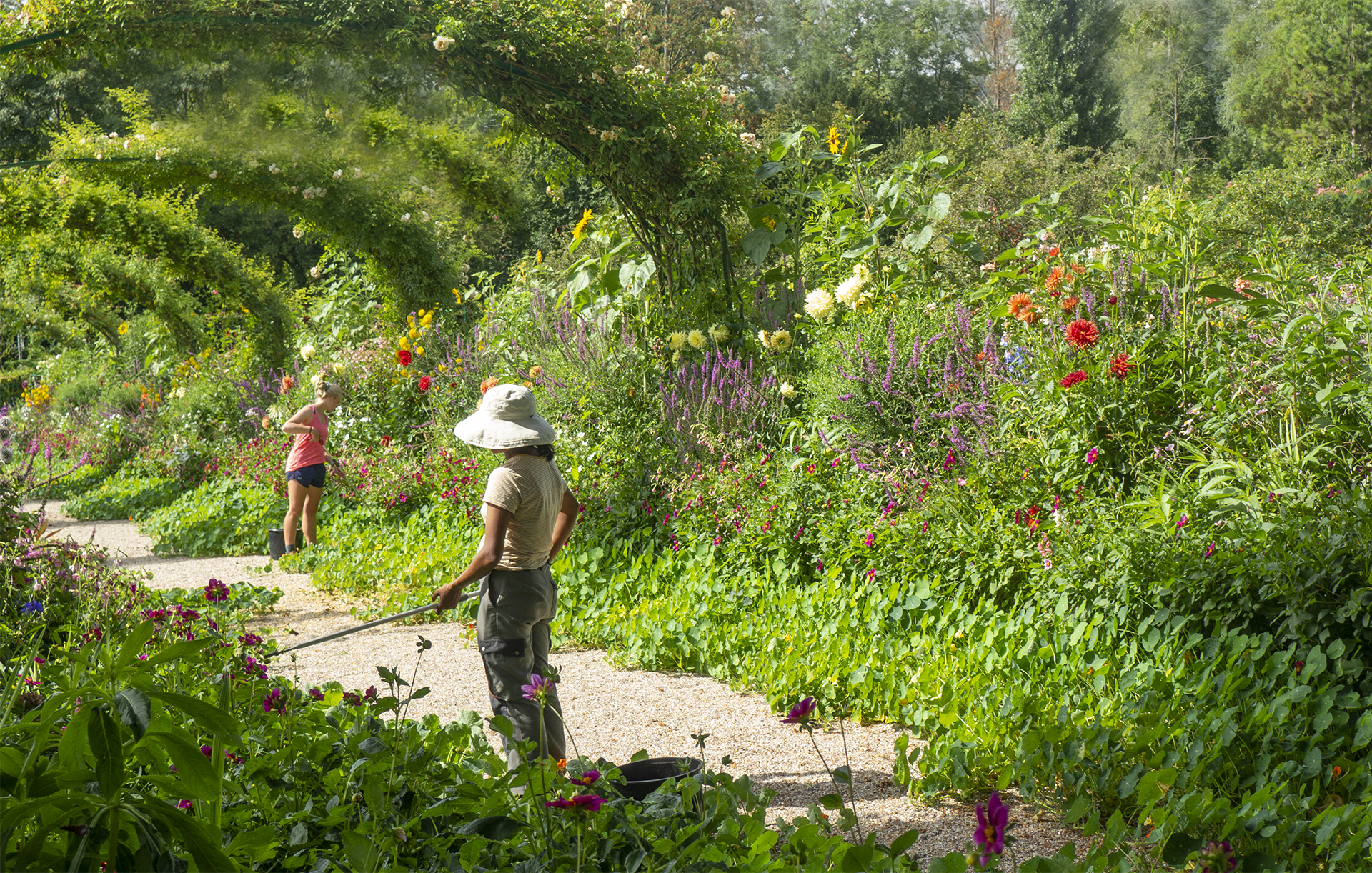
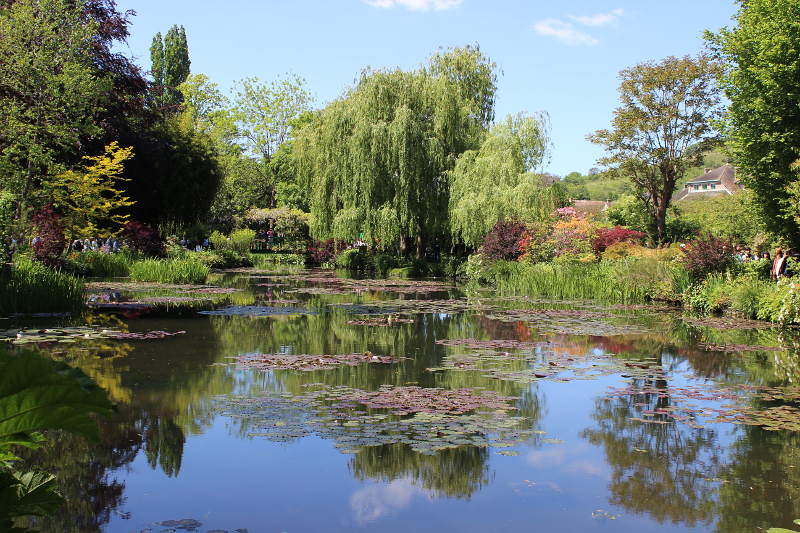
The Artist’s Garden at Giverny exists as a living testament to Claude Monet’s groundbreaking fusion of art and nature, transcending the boundaries of traditional artistic mediums, into realms more abstract and boundless.
Artists from various disciplines continue to draw inspiration from the vibrant colours, harmonious compositions, and ethereal beauty that define the beautiful garden at Giverny.
Photographers capture its ever-changing hues with mesmerising precision, while painters emulate Monet’s brushstrokes in an attempt to capture the fleeting moments of light and shadow he so masterfully portrayed.
The legacy of Giverny extends beyond mere aesthetics; it serves as a profound reflection on the interconnectedness of creativity and our natural world, much like Monet’s painting on oil on canvas.
Moreover, The Artist’s Garden at Giverny stands as a cultural emblem that blurs the distinction between horticulture and artistic expression.
Through meticulous planning and curation, Monet transformed his garden into a dynamic canvas where light played upon petals like paint on a palette, a transformation that would later grace the walls of art galleries worldwide.
This intentional merging of artistry with gardening practices revolutionized how landscapes are perceived—not merely as scenery but as intricate works of living artistry, capturing the attention of art galleries and print collectors alike.
Today, contemporary artists look to Giverny not only for its visual splendor but also for its innovative approach to intertwining human creativity with botanical ingenuity, often seeking to capture its essence in fine art prints.
In doing so, they embrace Monet’s philosophy that true beauty lies in harmony with nature—an idea as relevant now as it was during his time amidst these blooming corridors of inspiration in the artist’s garden in Giverny.
The Vibrant Flower of Giverny: A Palette of Inspiration
Immersing oneself in the enchanting realm of Claude Monet’s garden at Giverny is a journey that transcends mere observation; it is a symphony of colors, fragrances, and harmonious landscapes that beckon visitors to step into a living masterpiece.
For those considering a pilgrimage to this horticultural gem, practical tips can transform your visit from pleasant to profound.
Delve into the magic during quieter times like early mornings or weekdays to savor the tranquility that inspired Monet’s brushstrokes.
Stroll along the iconic Japanese bridge as its arches mirror in lily-dotted waters, and don’t neglect the vibrant Flower Garden where tulips dance in hues borrowed from Monet’s palette, reflecting the size and beauty of his artistic vision.
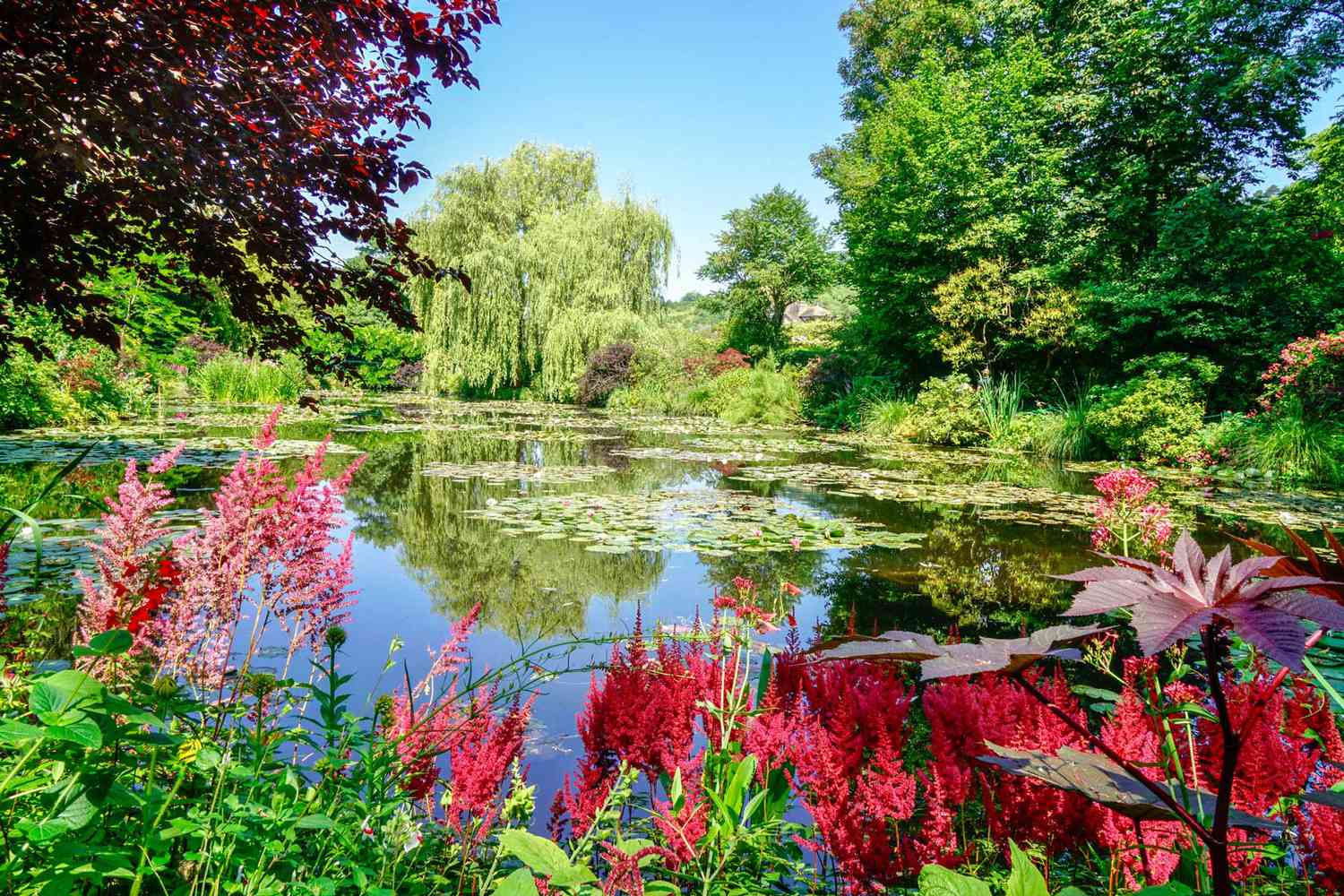
As echoes of How marvelous! Resonate, consider how the garden became the subject of awe in Claude Monet’s prints, admired in galleries around the world, giving us a glimpse into the artist’s abstract representation of nature.
I feel like I’m inside one of his paintings resonate through the air, visitors often find themselves unexpectedly moved by the ethereal beauty surrounding them.
One visitor recounted how gazing upon water lilies gently swaying under dappled sunlight evoked an overwhelming sense of serenity—a momentary escape from life’s frenetic pace captured by Monet centuries ago.
Another shared a sentiment echoed by many: amidst the blossoming tapestries of the artist’s garden in Giverny, one feels not just an observer but a partaker in nature’s grand opera conducted by petals and leaves.
Prepare your heart for whispers of inspiration amid blooms painted with light—Monet’s gift preserved in every petal’s brushstroke at Giverny.
Conclusion
Claude Monet’s vibrant plein air paintings, illuminated by dappled light, stand as quintessential embodiments of the Impressionist movement, which he played a pivotal role in establishing during late 19th-century France.
With meticulous observation, Monet depicted urban scenes, his iconic water lily gardens, haystacks, and pastoral landscapes, revisiting each setting multiple times to capture the nuances of changing light and atmosphere.
Through his masterful brushwork, Monet occasionally ventured into abstraction, while his rich color palettes set a precedent for 20th-century painting.
Monet’s esteemed works are prominently featured in esteemed institutions such as the Metropolitan Museum of Art, the Musée de l’Orangerie, the Art Institute of Chicago, the Museum of Fine Arts, Boston, among others.
Notably, in 2019, his painting “Meules” (1891) achieved a historic milestone as the most expensive Impressionist artwork ever sold at auction, fetching a staggering $110.7 million.
Georges Bernheim, Paris, Yale University Art Gallery & Provenance:
The artist; possibly sold to Georges Bernheim, Paris, 1918; Sir Alfred Chester Beatty (1875–1968), Dublin; Mrs. A.E., providing a glimpse into the historical provenance of Monet’s paintings. Pleydell-Bouverie, 1960; with Wildenstein and Company; Paul Mellon (1907-1999) and Rachel Lambert ‘Bunny’ Mellon (1910-2014), Upperville, Virginia, by 1966; gift to the Yale University Art Gallery, New Haven, Conn., 1983